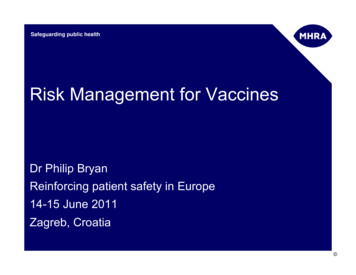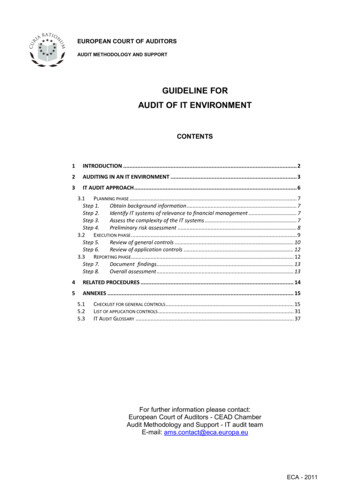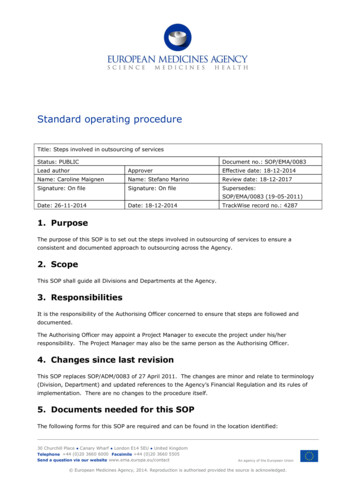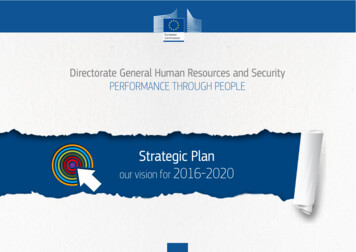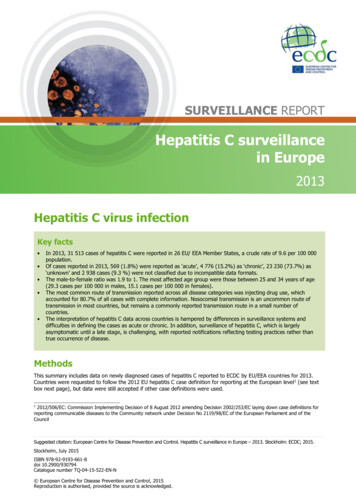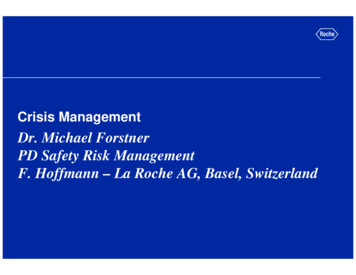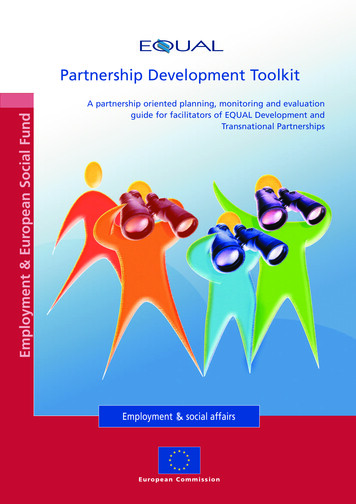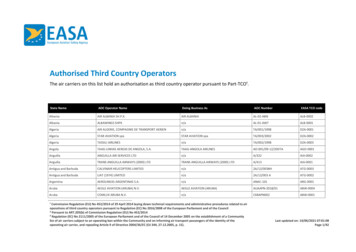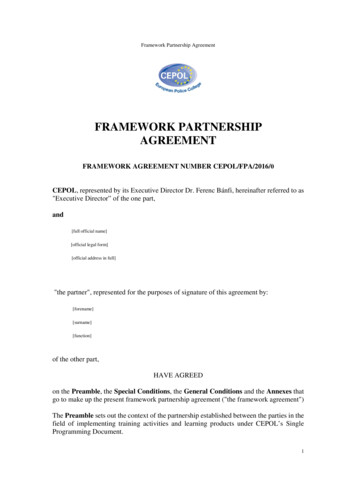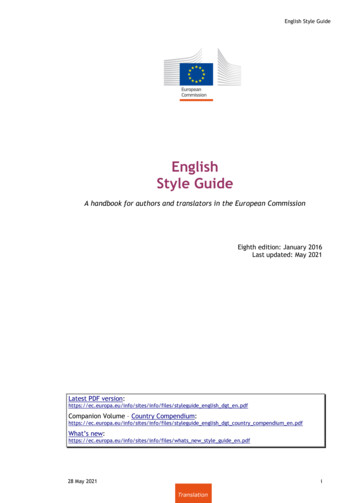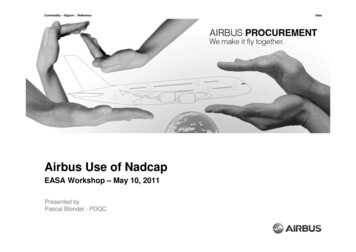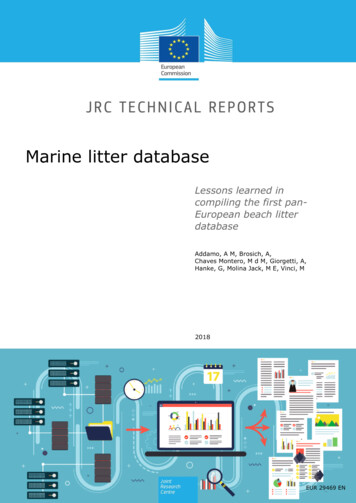
Transcription
Marine litter databaseLessons learned incompiling the first panEuropean beach litterdatabaseAddamo, A M, Brosich, A,Chaves Montero, M d M, Giorgetti, A,Hanke, G, Molina Jack, M E, Vinci, M20181EUR 29469 EN
This publication is a technical report by the Joint Research Centre (JRC), the European Commission’s scienceand knowledge service. It aims to provide evidence-based scientific support to the European policymakingprocess. The scientific output expressed does not imply a policy position of the European Commission. Neitherthe European Commission nor any person acting on behalf of the Commission is responsible for the use thatmight be made of this publication.Contact informationName: Georg HankeAddress: Joint Research Centre, Via Enrico Fermi 2749, I-21027 Ispra (VA), ItalyEmail: georg.hanke@ec.europa.euTel. 39-0332-785586EU Science Hubhttps://ec.europa.eu/jrcJRC112895EUR 29469 ENPrintISBN 978-92-79-97866-1ISSN 1018-5593doi:10.2760/68866PDFISBN 978-92-79-97867-8ISSN 1831-9424doi:10.2760/621710Luxembourg: Publications Office of the European Union, 2018 European Union, 2018The reuse policy of the European Commission is implemented by Commission Decision 2011/833/EU of12 December 2011 on the reuse of Commission documents (OJ L 330, 14.12.2011, p. 39). Reuse is authorised,provided the source of the document is acknowledged and its original meaning or message is not distorted. TheEuropean Commission shall not be liable for any consequence stemming from the reuse. For any use orreproduction of photos or other material that is not owned by the EU, permission must be sought directly fromthe copyright holders.All content European Union 2018Cover image Cifotart, Adobe Stock 2018How to cite this report: Addamo Anna Maria, Brosich Alberto, Chaves Montero Maria del Mar, GiorgettiAlessandra, Hanke Georg, Molina Jack Maria Eugenia, Vinci Matteo, Marine litter database: Lessons learned incompiling the first pan-European beach litter database, EUR 29469 EN, Publications Office of the EuropeanUnion, Luxembourg, 2018, ISBN 978-92-79-97867-8, doi:10.2760/621710, JRC112895.2
ContentsForeword . 2Acknowledgements . 3Abbreviations . 5Abstract . 61 Introduction . 71.1 Baseline concept and harmonised database. 91.2 Data guidance: template and vocabulary . 102 First pan-European beach litter database . 122.1 Metadata of EU beach litter data . 122.2 Challenges of and hindrances to data assembly . 172.3 European beach litter database . 183 Outlook and conclusion . 263.1 Contribution to further harmonisation. 263.2 Input to European policies . 263.3 Conclusion . 27References . 28Boxes. 30Figures . 31Tables . 32List of footnotes . 33Annexes . 34Annex 1. EMODnet Chemistry Beach Format Template — Beach Metadata . 34Annex 2. EMODnet Chemistry Beach Format Template — Survey Metadata . 36Annex 3. EMODnet Chemistry Beach Format Template — Litter Data . 39Annex 4. EMODnet Chemistry Beach Format Template — Animals . 39Annex 5. Number of beaches and surveys for each country and year. . 40Annex 6. List of non-compatibilities of litter categories and further suggestions. . 42Annex 7. Specific hindrances by country*. . 50i
ForewordThe Marine Directors of the European Union (EU), all EU Member States, accedingcountries, candidate countries and European Free Trade Association (EFTA) countries havejointly developed a common strategy for supporting the implementation of Directive2008/56/EC, the Marine Strategy Framework Directive (MSFD). The main aim of thisstrategy is to allow a coherent and harmonious implementation of the Directive. The focusof the strategy is on methodological questions related to a common understanding of thetechnical and scientific implications of the MSFD. In particular, one of the objectives of thestrategy is the development of non-legally binding and practical documents, such as thisreport, on various technical issues of the Directive. In order to support and advise thepolicy development and implementation process, the MSFD Technical Group on MarineLitter (TG Litter hereafter) has been set up as part of the MSFD Implementation Strategy.The TG Litter is led by Directorate General Environment (DG ENV) and is chaired by theFrench Research Institute for Exploitation of the Sea (Ifremer), the German EnvironmentAgency (UBA) and the European Commission Joint Research Centre (EC JRC) (1)).This report has been prepared by the EC JRC and EMODnet Chemistry Consortium, basedon data and information collected through and revised by the TG Litter.This publication is part of a series of technical reports on specific thematic topics, such asTop marine beach litter items in Europe: A review and synthesis based on beach litter data,Harm caused by marine litter, Identifying sources of marine litter, Riverine littermonitoring: Options and recommendations and Guidance on monitoring of marine litter inthe European seas. These thematic reports are aimed at those experts who are directly orindirectly implementing the MSFD in the marine regions.This technical report provides information to EU Member States on data quality and datamanagement in support of the MSFD and other European policies in determining baselinesand thresholds, implementing monitoring programmes and planning measures againstmarine litter.Disclaimer:This document has been developed through a collaborative programme involving theEuropean Commission, all EU Member States, acceding countries, Norway, internationalorganisations (including the Regional Sea Conventions and other stakeholders) and nongovernmental organisations. The document should be regarded as presenting an informalconsensus position on best practice agreed by all partners. However, the document doesnot necessarily represent the official, formal position of any of the partners. Hence, theviews expressed in the document do not necessarily represent the views of the EuropeanCommission.(1)Further information can be found on the website of the JRC MSFD Competencehttp://mcc.jrc.ec.europa.eu/dev.py?N 41&O 434&titre chap TG %20Marine %20Litter.2Centre:
AcknowledgementsThe authors would like to thank all Member States’ authorities, the Regional SeaConventions (OSPAR commission, Barcelona convention UN Environment/MAP, BalticMarine Environment Protection commission — Helsinki commission (Helcom), Black Seacommission), non-governmental organisations (NGOs), others who have contributed to thescope of this report by providing marine beach litter data, and all members of the TG Litter,and in particular David Fleet, Marta Ruiz, Lone Soederberg and Eva Blirberg for theircomments and suggestions, which have contributed to this report.Financial support was provided by EC DG MARE through the call for tenderEASME/EMFF/2016/006, Operation, development and maintenance of a European marineobservation and data network (EMODnet).Service Contract No EASME/EMFF/2016/1.3.1.2/Lot4/SI2.749773.For providing data, we would like to acknowledge:Member State authoritiesBulgaria: Stela Barova and Violeta Slabakova, Black Sea Basin Directorate to the Ministryof Environment and Water, Department Marine Waters Protection and Monitoring.Croatia: Pero Tutnam, Institute of Oceanography and Fisheries.Denmark (Baltic Sea): Lone Munk Søderberg, Danish Ministry of the Environment andFood; Jakob Strand, Aarhus University, Department of Bioscience — Marine Diversity andExperimental Ecology.Estonia: Marek Press, Keep the Estonian Sea Tidy Association; Agnes Unnuk and KatarinaOganjan, Ministry of the Environment of Estonia.Finland: Suikkanen Sanna, Finnish Environment Institute.France (Mediterranean Sea): Francois Galgani, French Research Institute for Exploitationof the Sea; Sophie Beauvais, French Biodiversity Agency; Camille Lacroix, French Centreof Documentation, Research and Experimentation on Accidental Water Pollution.Germany (Baltic Sea): Dennis Gräewe, State Agency for Environment, NatureConservation and Geology, Mecklenburg-Vorpommern, Division Geology, Water and Soil,Department Water Quality Inland and Coastal Water; Stefanie Werner, German FederalEnvironment Agency.Greece: DeFishGear Project/MIO-ECSDE; Thomais Vlachogianni, MediterraneanInformation Office for Environment, Culture and Sustainable Development.Latvia: Janis Ulme, Foundation for Environmental Education; Baiba Zasa, Ministry ofEnvironmental Protection and Regional Development of the Republic of Latvia.Lithuania: Laura Lauciutė, Environment Protection Agency, Marine Research Department.Poland: State Environmental Monitoring; Włodzimierz Krzymiński, Tamara Zalewska,National Research Institute, Institute of Meteorology and Water Management.Romania: Elena Stoica, National Institute for Marine Research and Development ‘GrigoreAntipa’.Slovenia: Andreja Palatinus and Manca Kovač Viršek, Institute for Water of the Republicof Slovenia.Spain: Marta Martínez-Gil Pardo de Vera, Ministry of Agriculture, Fisheries and Food.Directorate for Coast and Sea Sustainability.Sweden (Baltic Sea): MARLIN Project; Eva Blidberg, Keep Sweden Tidy; Johanna Eriksson,Swedish Agency for Marine and Water Management; Per Nilsson, Swedish Institute for theMarine Environment.3
Regional Sea Conventions and non-governmental organisationsOSPAR and Marine Conservation Society: Convention for the protection of the marineenvironment of the North-East Atlantic (OSPAR Commission) and Sue Kinsey, MarineConservation Society, for providing data from Belgium, Denmark (including the FaroeIslands), Ireland, Spain, Germany, France, Iceland, the Netherlands, Norway, Portugal,Sweden and the United Kingdom (North-East Atlantic region).Legambiente: Giorgio Zampetti and Stefania Divito for providing NGO data from Italy.Isotech Ltd: Environmental research and consultancy for data collected in Cyprus.Non-EU Member StatesGeorgia: Kakhaber Bilashvili, Institute of Oceanography and Hydrology of IvaneJavakhishvili Tbilisi State University (TSU).Montenegro: Anna Castelli, Institute of Marine Biology.Russia and Ukraine: EMBLAS II Project; Maria Pogojeva, State Oceanographic Institute(SOI).AuthorsAnna Maria, Addamo, European Commission DG Joint Research Centre, Directorate D —Sustainable Resources, Unit D.02 Water and Marine Resources, I-21027 Ispra (VA) — Italy.Alberto, Brosich, Istituto Nazionale di Oceanografia e Geofisica Sperimentale, Borgo GrottaGigante, 42/c, IT-34010 Sgonico (TS) — Italy.María del Mar, Chaves Montero, Istituto Nazionale di Oceanografia e GeofisicaSperimentale, Borgo Grotta Gigante, 42/c, IT-34010 Sgonico (TS) — Italy.Alessandra, Giorgetti, Istituto Nazionale di Oceanografia e Geofisica Sperimentale, BorgoGrotta Gigante, 42/c, IT-34010 Sgonico (TS) — Italy.Georg, Hanke, European Commission DG Joint Research Centre, Directorate D —Sustainable Resources, Unit D.02 Water and Marine Resources, I-21027 Ispra (VA) — Italy.Maria Eugenia, Molina Jack, Istituto Nazionale di Oceanografia e Geofisica Sperimentale,Borgo Grotta Gigante, 42/c, IT-34010 Sgonico (TS) — Italy.Matteo, Vinci, Istituto Nazionale di Oceanografia e Geofisica Sperimentale, Borgo GrottaGigante, 42/c, IT-34010 Sgonico (TS) — Italy.4
AbbreviationsDeFishGearProject on derelict fishing gear management system in the Adriatic regionDG ENVDirectorate-General for EnvironmentDG GROWDirectorate-General for Internal Market, Industry, Entrepreneurship andSMEsECEuropean CommissionEFTAEuropean Free Trade AssociationEmblasEnvironmental monitoring of the Black SeaEMODnetEuropean Marine Observation and Data NetworkEUEuropean UnionGESgood environmental statusG7Group of SevenG20Group of 20HelcomBaltic Marine Environment Protection Commission — Helsinki CommissionIfremerFrench Research Institute for Exploitation of the SeaInspireInfrastructure for spatial information in EuropeJRCJoint Research CentreMARLINProject on Marine Littering the Baltic Sea AreaMIO-ECSDEMediterranean Information Office for Environment, Culture and SustainableDevelopmentMSMember StateMSFDMarine Strategy Framework DirectiveNGOnon-governmental organisationOSPARConvention for the protection of the
Marine litter database Lessons learned in compiling the first pan-European beach litter database Addamo, A M, Brosich, A, Chaves Montero, M d M, Giorgetti, A, Hanke, G, Molina Jack, M E, Vinci, M 2018 EUR 29469 EN . 2 This publication is a technical report by the Joint Research Centre (JRC), the European Commission’s science and knowledge service. It aims to provide evidence-based scientific .

